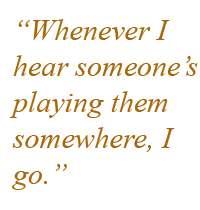The Uilleann Pipes: A Long-Standing Element of Traditional Irish Music
Story by Andrew Harrington
 A beautiful droning baritone note fills the room, followed by a bouncing melody that speaks of the surrounding green hills filled with sheep. Twelve-year-old Damian Bannon of Cavan is just one of the many musicians young and old devoted to playing the Uilleann pipes and preserving their place in traditional Irish music. On Saturday, July 28th in Coalisland young musicians competed in the Northern Ireland Fleadh Cheoil Uladh. The Fleadh Cheoil Uladh is a music festival and competition among amateur musicians in the junior and senior categories. Over 250 musicians competed across Ulster in over 70 competitions in traditional music, song, language, and dance. The purpose of the competition was to provide an expanded program of events to suit different traditional disciplines. Damian Bannon was a confident young piper. He played two tunes effortlessly on his Uilleann pipes in front of the judges, before going to sit next to his family and friends. A beautiful droning baritone note fills the room, followed by a bouncing melody that speaks of the surrounding green hills filled with sheep. Twelve-year-old Damian Bannon of Cavan is just one of the many musicians young and old devoted to playing the Uilleann pipes and preserving their place in traditional Irish music. On Saturday, July 28th in Coalisland young musicians competed in the Northern Ireland Fleadh Cheoil Uladh. The Fleadh Cheoil Uladh is a music festival and competition among amateur musicians in the junior and senior categories. Over 250 musicians competed across Ulster in over 70 competitions in traditional music, song, language, and dance. The purpose of the competition was to provide an expanded program of events to suit different traditional disciplines. Damian Bannon was a confident young piper. He played two tunes effortlessly on his Uilleann pipes in front of the judges, before going to sit next to his family and friends.
Wherever you go in Ireland, you are bound to find some sort of traditional folk music playing in pubs. Some common folk instruments found in these casual settings are the button accordion, the bodhran, the acoustic guitar, the harp, and the fiddle, among others, though none of these seem to evoke the same level of reverence that the Uilleann pipes do for Irish musicians.
A complicated instrument, the Uilleann pipes prove to be a rewarding challenge for any accomplished musician. Unlike the Scottish highland bagpipes, the Uilleann pipes have an airsac that is inflated through a pumping action with the arm. The Uilleanns have a greater range of notes than their Scottish counterparts; they can play two full octaves of notes within a scale. The Scottish pipes are limited to the first nine. In both instruments the notes are changed on the chanter, which resembles a flute and which is attached to the bag or airsac. The instruments are made all over the world, wherever cane grows.
The Uilleann pipes as we know them today developed in the eighteenth century, but bellows’ blown pipes date back a hundred years earlier in France, Spain, and other European c countries. Over the years, the instrument has been modified to include more sharp and flat keys and thus to give the pipes a richer, more diverse sound.
After the competition at Fleadh Cheoil Uladh, pipers filled Coalisland. In the Canal End Bar, a lively place filled with those of all ages, from the young ones barely able to tie their shoes to older folks who have seen all sorts of barroom shenanigans, Greg Wilkinson, a native of Donegal, speaks of his love of the Uilleann pipes, “I go where they are. Whenever I hear someone’s playing them somewhere, I go.”

J. B. Vallely is one such piper. Vallely comes from a diversely talented family of musicians, painters, and teachers who try to preserve Irish traditional music and the Uilleann pipes for future generations. Vallely has been playing the pipes as well as the tin whistle for 40 years. “I was attracted to the sound of the pipes. That was the simple motivation. It’s a fairly unique Irish instrument,” he says. No one was teaching the pipes when he wanted to learn but he already played the flute so he taught himself to play the pipes by watching other pipers play to see how they did it.
He now teaches students at the Armagh Piper’s Club and serves as its secretary and public relations officer. The club has over a hundred members, young and old, who teach and play instruments together and in pubs with other musicians. Children are encouraged as early as four years old to learn how to sing. At the age of seven, some of them learn instruments like the tin whistle, the fiddle, and the harp, as well as the pipes.
Vallely’s house contains evidence of his love of the arts. Oil paintings of musicians and athletes lie stacked in piles or hang, some still wet. The sitting room contains a large case that holds a full set of Uilleann pipes with a tasseled, brown bag. Vallely plays a beautiful short jig that lasts a few moments.
When asked about the future of Irish folk music, Vallely said that a lot has happened in the last fifty years. Irish music has been taken to an international level, everywhere from Japan and Australia to the United States. He assumes there will continue to be more demand for pipe and flute classes in all of Ireland.
Story by Andrew Harrington
Photos by Meg Carey
Video by Christine Slomski
Web Desgin by Nora Daly
|

